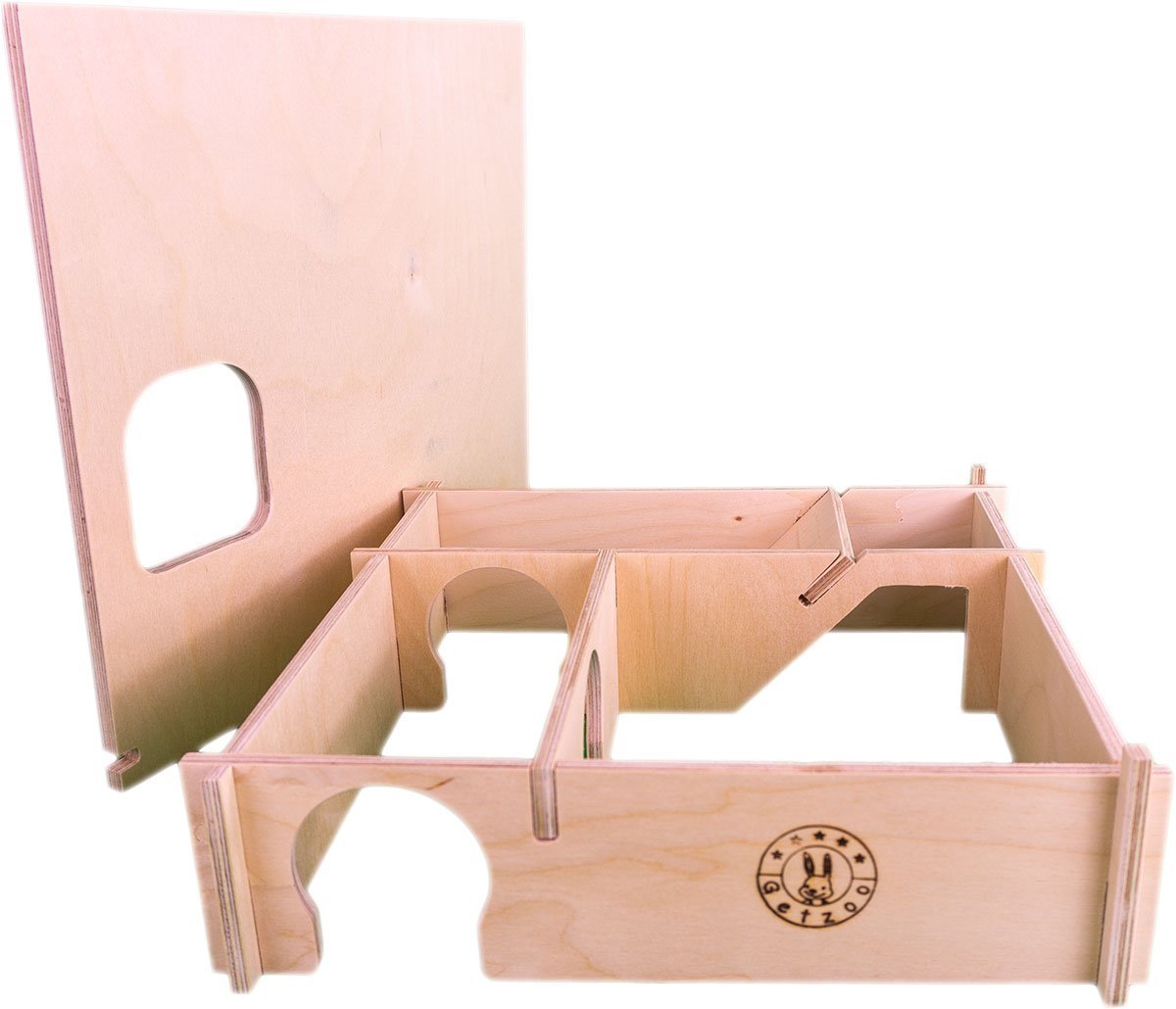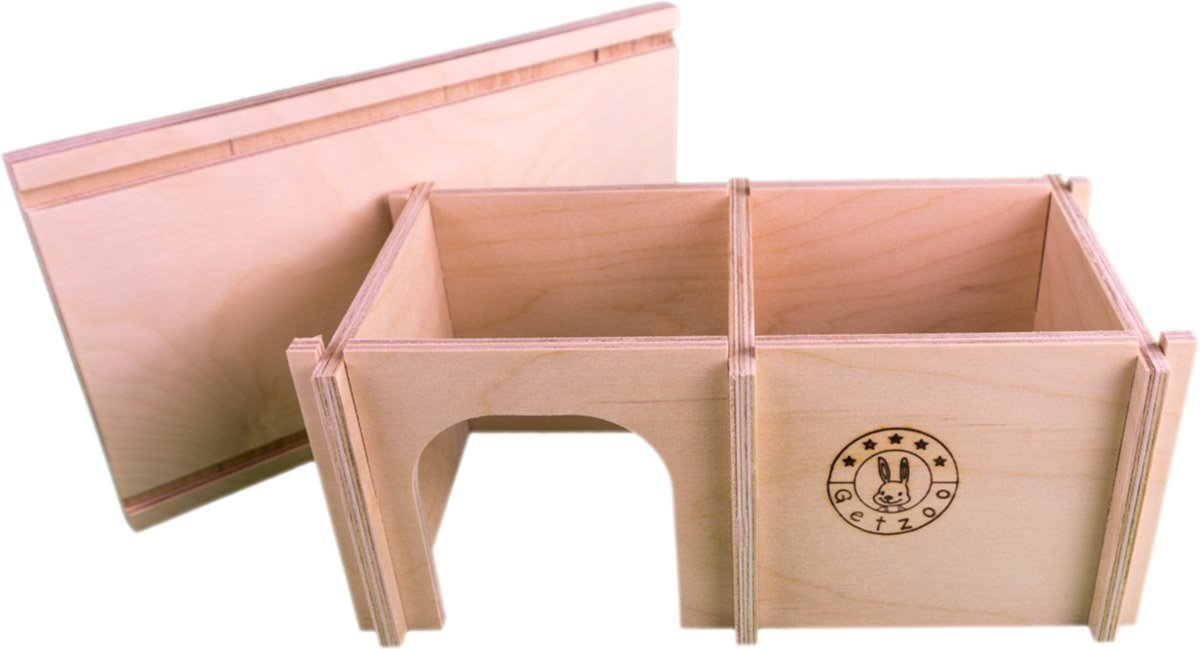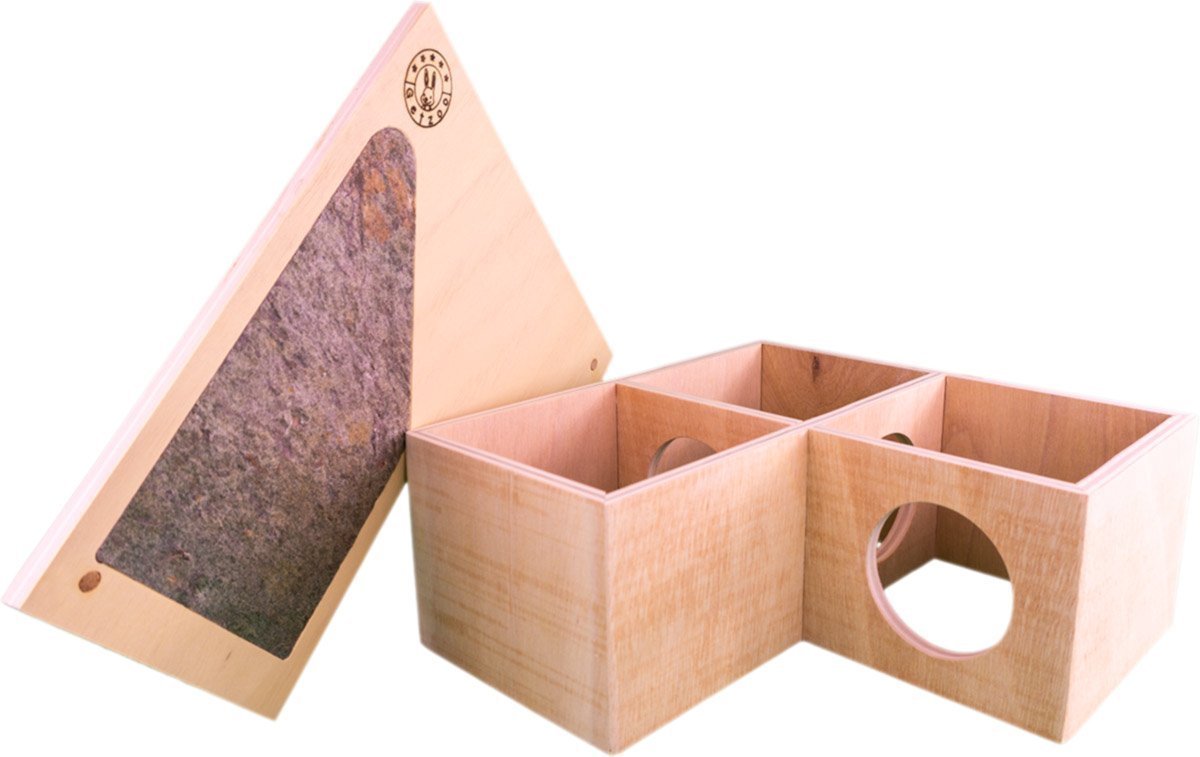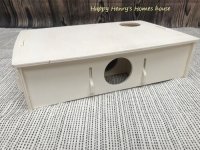Photo of Happy Henry's Homes Large chamber house (linked below)
Houses or nesting boxes in the cage are important for hamsters, as they can mimic an underground burrow so the hamster can have more normal behaviours and keep their own environment organised and even clean sometimes.
Most commercial cages come with tiny little plastic houses with a solid base. These are not good. Yes a hamster will fit in it, but hamsters need to build large nests - partly to keep warm in cold weather, and partly because it's what makes them feel secure. If they only have a little plastic house they will try to nest and hoard in it and it will get messed up and need cleaning out too much (which will stress the hamster). It can also get damp and mouldy inside from condensation.
Hamsters do best with a house that is basically a nesting box and
1) Is open underneath and sat directly on the substrate. Hamsters are basically ground dwellers and like to bury hoards under their nest. Also this allows the house to keep ventilated and not be too closed up.
2) Large enough for them to build a big nest in and also have room for hoards as well. In fact if you give a hamster a large enough house, they will move their toilet corner into a corner of the house, away from the nest. They will treat it like a burrow where they have separate areas for nesting, toiletting and sleeping. A good example of this is a shoebox house. This is easy to make - you cut the base of the shoebox out and keep the lid for a lift off roof, and cut a hole for a door. Ideally make the door at one end of one of the long sides (this means the other end is dark inside - light doesn't go round corners). The hamster will always nest in the darkest end of the house. And you can then fit a corner litter tray in the back corner opposite the entrance. For some reason hamsters like an ensuite bathroom! Presumably they like they privacy of toiletting and eating all in one darker, secure area. They will often go straight to the litter tray as soon as they wake up, have a wash and then emerge from the house. As mentioned before, they are actually very clean little things, if things are set up right for them.
3) Dark inside. As mentioned above, this can be achieved by having a door at one end of a long side of a shoebox house for example. It can be further achieved by putting a bendy stick bridge or tunnel over the entrance - this means it is definitely dark inside and also provides a ramp up onto the house roof.
4) Ideally with a lift off roof. This isn't essential but it really helps. It means you don't need to remove the house from the cage (avoiding the hamster's nest falling apart) and can just lift off the roof to check inside, when needed - either to take the litter tray out and empty it, or just check it's clean inside). If it's also a flat roof, this doubles up as a shelf and you can put a food bowl on top.
5) It must have a correct size entrance door to prevent a hamster becoming stuck (this is an emergency). For a dwarf hamster the minimum diameter for a door is 5cm. For a Syrian hamster a door should be at least 7cm. A Syrian hamster with full pouches can easily be 6 or 7 cm wide! This is more the case for ceramic, wood and plastic houses. For cardboard houses - easy - you just cut the door a bit bigger!
Shoe box house
For a Syrian hamster, a standard sized cardboard shoe box is a good sized house. A smaller house is ok but you won't be able to fit a litter tray inside it - in that case the hamster usually chooses a corner of the cage as it's toilet and you can put a litter tray there instead.
For a dwarf hamster - a child's sized cardboard shoe box makes a good sized house - or a tissue box perhaps. Again - cardboard is your friend! For making hamster items.
Wood houses and Multiroom houses
Wood is also good for hamster houses as it breathes - it can also get pee soaked so with smooth wood it's a good idea to paint the inside with pet-safe waterproofing paint so it's wipe clean. In the Uk "Plastikote" comes in little pots of water based waterproofing paint and is virtually odourless. If it's a bark wood or rough wood house this won't be possible. However sometimes if a wood house does get pee soaked, just scrubbing the inside with water does the trick. In Germany some people even stick little ceramic tiles inside the house. In the area where a litter tray is to go.
Ceramic or plastic houses
These aren't good as a main nesting box, but can be ok for extra hidey places. For Ceramic hides it's imperative to check the size of any entrance doors as they are not possible to enlarge if a hamster got stuck. You would probably need to break the ceramic house to get the hamster unstuck - which could cause injury to the hamster (or it might die of fright and stress if stuck for some time).
So entrance sizes are extremely important.
Litter trays, toiletting and "ensuite" bathrooms!
Back to toiletting. Occasionally some hamsters will pee in their nest. This is usually only when they are very young and haven't developed a routine or good habits. It might only happen once or twice until they get used to having a particular toilet area or using a litter tray.
But once a hamster is using a litter tray their nest is kept very clean and hardly ever needs to be removed. The hamster is very precious about their nest and they can refurbish it themselves ongoing - adding new nesting material and chucking out any old bits. It is surprising how clean and dry their nest can stay for a very very long time. As such it's best not to disturb their nest unless it's pee'd in. It is their bed after all and they like to sleep in comfort. Usually!
It depends what size cage you have as to how big a house you can fit in. There are some amazing hamster houses available these days which work really well for hamsters. They are not always cheap though. A shoebox house is cheap!
Multiroom or labyrinth houses work very well and the hamsters natural instincts are catered for - they will nest in one room, hoard in another and toilet in another. They may still just bury hoards under the nest but they will use a separate room for a toilet - and that's where you put the litter tray.
Where to find good hamster houses
Rodipet and Getzoo both make amazing multiroom and labyrinth houses. In different sizes for the different species of hamster. These are both German companies but ship elsewhere in Europe and to the Uk. See below .......
Happy Henry's Homes in the Uk also makes their own range of houses, multiroom houses and other hamster items. See below ..........
Amazon sells a lot of Trixie wood items. The Trixie Leif Labyrinth house is quite good - but really only suitable for dwarf hamsters as the entrances are only 5cm and the interior compartments are small for a Syrian - although some people knock out the inner divider for a Syrian to make a bigger compartment. But a litter tray wouldn't fit in as well.
Basically if a hamster has a large house or multi roomed house, they will almost always move their toilet area inside the house, away from the nest - so the house needs to be able to fit a litter tray in. If they have a smaller house they will usually choose a corner of the cage as a toilet area (but may be much happier in a larger house!).
If the hamster feels safe and secure in a nice dark house with room for a large nest, they can have normal behaviours and will be less stressed and more relaxed (and less inclined to bar chew or chew cage corners).
Below are some examples of good houses and multiroom houses.
Supporting large houses underneath
A final note - large wood houses need to be supported underneath - otherwise the hamster can tunnel under them and the house could fall on them and squash them. Some houses come with "legs" you can attach, or you can glue dowels to the house to make legs. attach "legs" to the house (or stilts) to support it - by glueing some dowels to it (some houses come with attachable legs you can buy). This keeps the house stable and secure and there is plenty of substrate underneath for burrowing down or burying hoards.
Unless it's a cardboard house! Then it doesn't need any support.
Some people have even made their own cardboard labyrinth houses. Cardboard houses have a lot of pros and cons. They are easily replaced if they become soiled or wet. On the other hand some hamsters (especially some maverick female hamsters) will see cardboard as something to rip to shreds!
Finally - if there isn't a suitable sized house in the cage the hamster may ignore it and just build an open nest in a corner of the cage or under a shelf - this makes cleaning a bit harder and the nest is more likely to collapse, which upsets them. Or they may use a small house but try and stuff too much into it and then get stressed when it doesn't work very well.
Rodipet labyrinth houses:
Rodipet have recently changed their range of labyrinth houses but they are similar to the old ones. They also sell legs for their houses.
This is a Syrian sized one
 www.rodipet.co.uk
www.rodipet.co.uk
This is a Dwarf hamster sized one
 www.rodipet.co.uk
www.rodipet.co.uk
They also make smaller two roomed houses for Syrians
 www.rodipet.co.uk
www.rodipet.co.uk
All these houses also come with a granite slab on top. This provides a cool place to sit in hot weather and also helps keep a hamster's nails from getting overgrown - if you keep a food bowl on there - every time they go to eat, their nails get roughened a bit by the stone slab. However you can just buy a stone or granite tile to put on top of any other house (or a terracotta plant pot base which has a similar effect). Rodipet do sell a rough granite tile separately,
Getzoo houses: Getzoo make better labyrinth houses for dwarf hamsters than Syrian hamsters but have good 2 or 3 room houses for Syrians
Dwarf hamster sized labyrinth house

 www.getzoo.de
www.getzoo.de
Small two roomed Syrian sized house (not that small!)

 www.getzoo.de
www.getzoo.de
Three roomed Syrian sized house with cool slab on roof

 www.getzoo.de
www.getzoo.de
Happy Henry's Homes:
A range of multi-room and smaller houses plus platforms. They also sell legs for their houses. These are also nail free and also say formaldehyde free which is good!
 www.happyhenryshomes.co.uk
www.happyhenryshomes.co.uk
Trixie Leif Labyrinth house
Suitable for a dwarf hamster, or for a small syrian hamster with the inside panel knocked out - watch out for nails with this house though - nails are used to make it so it needs checking to make sure none are protruding. The same warning goes for nearly all rough barkwood items sold for hamsters. The other houses listed above don't use any nails, and use safe wood and petsafe glue.
Suitable corner litter tray for a Syrian hamster - to fit inside a large house or labyrinth house. Rodipet also make syrian sized and smaller dwarf sized ceramic litter trays that fit in corners in houses. The best thing to use in a litter tray is Chinchilla Bathing sand or sterilised childrens play sand. It soaks up the pee and can be emptied out once or twice a week - keeps the cage clean and dry! "Potty litter" sold for hamsters is not too bad, but works out expensive and can be unsafe if the hamster decides to try and eat it - so sand is much safer (and works out cheaper). You could also just put substrate in it but it would need emptying more often then. Hamsters will often cover a sand potty with substrate anyway - to keep the smell down - after all, it's in their house!
There are other wood houses available on Amazon and other stores, but most of them don't have a lift off roof and quality control can be very bad these days with very roughly made or splintery items - to the point they need returning. So be careful.
In addition to a main house for a hamster to nest in, they also enjoy plenty of other hides and hidey places to hang out in. Ceramic hides are good for this (they do well on a shelf as they are heavier items) or coconut huts or cardboard tissue box or egg box hides.
Photo courtesy of Happy Henry's Homes
Houses or nesting boxes in the cage are important for hamsters, as they can mimic an underground burrow so the hamster can have more normal behaviours and keep their own environment organised and even clean sometimes.
Most commercial cages come with tiny little plastic houses with a solid base. These are not good. Yes a hamster will fit in it, but hamsters need to build large nests - partly to keep warm in cold weather, and partly because it's what makes them feel secure. If they only have a little plastic house they will try to nest and hoard in it and it will get messed up and need cleaning out too much (which will stress the hamster). It can also get damp and mouldy inside from condensation.
Hamsters do best with a house that is basically a nesting box and
1) Is open underneath and sat directly on the substrate. Hamsters are basically ground dwellers and like to bury hoards under their nest. Also this allows the house to keep ventilated and not be too closed up.
2) Large enough for them to build a big nest in and also have room for hoards as well. In fact if you give a hamster a large enough house, they will move their toilet corner into a corner of the house, away from the nest. They will treat it like a burrow where they have separate areas for nesting, toiletting and sleeping. A good example of this is a shoebox house. This is easy to make - you cut the base of the shoebox out and keep the lid for a lift off roof, and cut a hole for a door. Ideally make the door at one end of one of the long sides (this means the other end is dark inside - light doesn't go round corners). The hamster will always nest in the darkest end of the house. And you can then fit a corner litter tray in the back corner opposite the entrance. For some reason hamsters like an ensuite bathroom! Presumably they like they privacy of toiletting and eating all in one darker, secure area. They will often go straight to the litter tray as soon as they wake up, have a wash and then emerge from the house. As mentioned before, they are actually very clean little things, if things are set up right for them.
3) Dark inside. As mentioned above, this can be achieved by having a door at one end of a long side of a shoebox house for example. It can be further achieved by putting a bendy stick bridge or tunnel over the entrance - this means it is definitely dark inside and also provides a ramp up onto the house roof.
4) Ideally with a lift off roof. This isn't essential but it really helps. It means you don't need to remove the house from the cage (avoiding the hamster's nest falling apart) and can just lift off the roof to check inside, when needed - either to take the litter tray out and empty it, or just check it's clean inside). If it's also a flat roof, this doubles up as a shelf and you can put a food bowl on top.
5) It must have a correct size entrance door to prevent a hamster becoming stuck (this is an emergency). For a dwarf hamster the minimum diameter for a door is 5cm. For a Syrian hamster a door should be at least 7cm. A Syrian hamster with full pouches can easily be 6 or 7 cm wide! This is more the case for ceramic, wood and plastic houses. For cardboard houses - easy - you just cut the door a bit bigger!
Shoe box house
For a Syrian hamster, a standard sized cardboard shoe box is a good sized house. A smaller house is ok but you won't be able to fit a litter tray inside it - in that case the hamster usually chooses a corner of the cage as it's toilet and you can put a litter tray there instead.
For a dwarf hamster - a child's sized cardboard shoe box makes a good sized house - or a tissue box perhaps. Again - cardboard is your friend! For making hamster items.
Wood houses and Multiroom houses
Wood is also good for hamster houses as it breathes - it can also get pee soaked so with smooth wood it's a good idea to paint the inside with pet-safe waterproofing paint so it's wipe clean. In the Uk "Plastikote" comes in little pots of water based waterproofing paint and is virtually odourless. If it's a bark wood or rough wood house this won't be possible. However sometimes if a wood house does get pee soaked, just scrubbing the inside with water does the trick. In Germany some people even stick little ceramic tiles inside the house. In the area where a litter tray is to go.
Ceramic or plastic houses
These aren't good as a main nesting box, but can be ok for extra hidey places. For Ceramic hides it's imperative to check the size of any entrance doors as they are not possible to enlarge if a hamster got stuck. You would probably need to break the ceramic house to get the hamster unstuck - which could cause injury to the hamster (or it might die of fright and stress if stuck for some time).
So entrance sizes are extremely important.
Litter trays, toiletting and "ensuite" bathrooms!
Back to toiletting. Occasionally some hamsters will pee in their nest. This is usually only when they are very young and haven't developed a routine or good habits. It might only happen once or twice until they get used to having a particular toilet area or using a litter tray.
But once a hamster is using a litter tray their nest is kept very clean and hardly ever needs to be removed. The hamster is very precious about their nest and they can refurbish it themselves ongoing - adding new nesting material and chucking out any old bits. It is surprising how clean and dry their nest can stay for a very very long time. As such it's best not to disturb their nest unless it's pee'd in. It is their bed after all and they like to sleep in comfort. Usually!
It depends what size cage you have as to how big a house you can fit in. There are some amazing hamster houses available these days which work really well for hamsters. They are not always cheap though. A shoebox house is cheap!
Multiroom or labyrinth houses work very well and the hamsters natural instincts are catered for - they will nest in one room, hoard in another and toilet in another. They may still just bury hoards under the nest but they will use a separate room for a toilet - and that's where you put the litter tray.
Where to find good hamster houses
Rodipet and Getzoo both make amazing multiroom and labyrinth houses. In different sizes for the different species of hamster. These are both German companies but ship elsewhere in Europe and to the Uk. See below .......
Happy Henry's Homes in the Uk also makes their own range of houses, multiroom houses and other hamster items. See below ..........
Amazon sells a lot of Trixie wood items. The Trixie Leif Labyrinth house is quite good - but really only suitable for dwarf hamsters as the entrances are only 5cm and the interior compartments are small for a Syrian - although some people knock out the inner divider for a Syrian to make a bigger compartment. But a litter tray wouldn't fit in as well.
Basically if a hamster has a large house or multi roomed house, they will almost always move their toilet area inside the house, away from the nest - so the house needs to be able to fit a litter tray in. If they have a smaller house they will usually choose a corner of the cage as a toilet area (but may be much happier in a larger house!).
If the hamster feels safe and secure in a nice dark house with room for a large nest, they can have normal behaviours and will be less stressed and more relaxed (and less inclined to bar chew or chew cage corners).
Below are some examples of good houses and multiroom houses.
Supporting large houses underneath
A final note - large wood houses need to be supported underneath - otherwise the hamster can tunnel under them and the house could fall on them and squash them. Some houses come with "legs" you can attach, or you can glue dowels to the house to make legs. attach "legs" to the house (or stilts) to support it - by glueing some dowels to it (some houses come with attachable legs you can buy). This keeps the house stable and secure and there is plenty of substrate underneath for burrowing down or burying hoards.
Unless it's a cardboard house! Then it doesn't need any support.
Some people have even made their own cardboard labyrinth houses. Cardboard houses have a lot of pros and cons. They are easily replaced if they become soiled or wet. On the other hand some hamsters (especially some maverick female hamsters) will see cardboard as something to rip to shreds!
Finally - if there isn't a suitable sized house in the cage the hamster may ignore it and just build an open nest in a corner of the cage or under a shelf - this makes cleaning a bit harder and the nest is more likely to collapse, which upsets them. Or they may use a small house but try and stuff too much into it and then get stressed when it doesn't work very well.
Rodipet labyrinth houses:
Rodipet have recently changed their range of labyrinth houses but they are similar to the old ones. They also sell legs for their houses.
This is a Syrian sized one
Rodipet® furling Goldi Large
ʄʋʀɬɨɴɡ: A Unique Home In a burrow deep within the bedding, there lived a hamster. This was no ordinary burrow - it was not a dirty, ...
This is a Dwarf hamster sized one
Rodipet® furling Dwarf Medium
Pet Rodent Supplies and Feeds by Rodipet® - natural✔ convenient✔ species-appropriate✔ Our own brands are designed to cater for all aspects of keeping ...
They also make smaller two roomed houses for Syrians
Rodipet® furling Goldi Small
Pet Rodent Supplies and Feeds by Rodipet® - natural✔ convenient✔ species-appropriate✔ Our own brands are designed to cater for all aspects of keeping ...
All these houses also come with a granite slab on top. This provides a cool place to sit in hot weather and also helps keep a hamster's nails from getting overgrown - if you keep a food bowl on there - every time they go to eat, their nails get roughened a bit by the stone slab. However you can just buy a stone or granite tile to put on top of any other house (or a terracotta plant pot base which has a similar effect). Rodipet do sell a rough granite tile separately,
Getzoo houses: Getzoo make better labyrinth houses for dwarf hamsters than Syrian hamsters but have good 2 or 3 room houses for Syrians
Dwarf hamster sized labyrinth house

Getzoo Wohnlabyrinth Xena
Ein gemütliches Zuhause für Chinchillas , Degus , Farbmäuse , Goldhamster , Rennmäuse und Zwerghamster Ihr Nager ist eine eigene kleine Persönlichkeit. Er hat Vorlieben, was seinen Schlafplatz oder seine...
Small two roomed Syrian sized house (not that small!)

Getzoo Goldhamsterhaus
Ein gemütliches Zuhause für Goldhamster , Rennmäuse , Degus , Stachelmäuse, u.v.a.m. Hamster und die meisten anderen Kleinnager tragen…
Three roomed Syrian sized house with cool slab on roof

Getzoo Eckhaus Luna mit Schieferdach
Geräumiges und kuscheliges Eckhaus für Zwerghamster, Goldhamster , Degus oder Mäuse Unsere Produkte sind so gestaltet, dass sie die artgerechte Haltung Ihrer Tiere unterstützen: Mit einer Grundfläche von 31x 31 cm und einer...
Happy Henry's Homes:
A range of multi-room and smaller houses plus platforms. They also sell legs for their houses. These are also nail free and also say formaldehyde free which is good!
Hamsters | Happy Henry’s Homes
Slot together modular hamster homes and houses, as well as sand and burrowing boxes, and other accessories. All made from robust, sustainably sourced materials and delivered in eco-friendly packaging.
 www.happyhenryshomes.co.uk
www.happyhenryshomes.co.uk
Trixie Leif Labyrinth house
Suitable for a dwarf hamster, or for a small syrian hamster with the inside panel knocked out - watch out for nails with this house though - nails are used to make it so it needs checking to make sure none are protruding. The same warning goes for nearly all rough barkwood items sold for hamsters. The other houses listed above don't use any nails, and use safe wood and petsafe glue.
Suitable corner litter tray for a Syrian hamster - to fit inside a large house or labyrinth house. Rodipet also make syrian sized and smaller dwarf sized ceramic litter trays that fit in corners in houses. The best thing to use in a litter tray is Chinchilla Bathing sand or sterilised childrens play sand. It soaks up the pee and can be emptied out once or twice a week - keeps the cage clean and dry! "Potty litter" sold for hamsters is not too bad, but works out expensive and can be unsafe if the hamster decides to try and eat it - so sand is much safer (and works out cheaper). You could also just put substrate in it but it would need emptying more often then. Hamsters will often cover a sand potty with substrate anyway - to keep the smell down - after all, it's in their house!
There are other wood houses available on Amazon and other stores, but most of them don't have a lift off roof and quality control can be very bad these days with very roughly made or splintery items - to the point they need returning. So be careful.
In addition to a main house for a hamster to nest in, they also enjoy plenty of other hides and hidey places to hang out in. Ceramic hides are good for this (they do well on a shelf as they are heavier items) or coconut huts or cardboard tissue box or egg box hides.
Photo courtesy of Happy Henry's Homes

